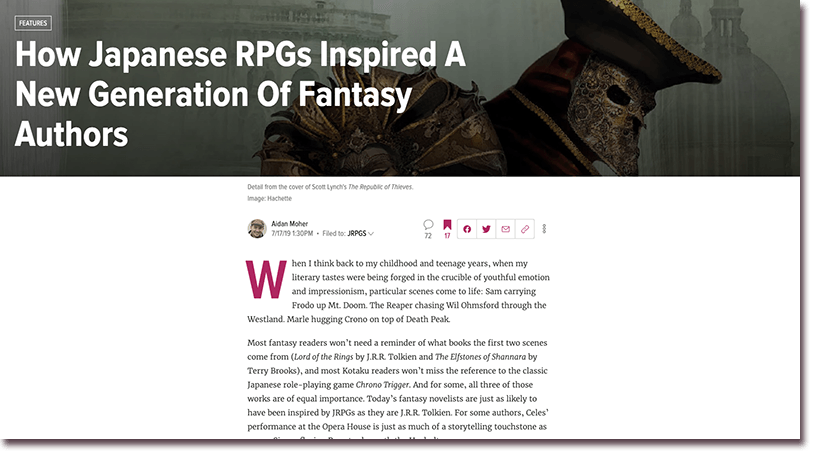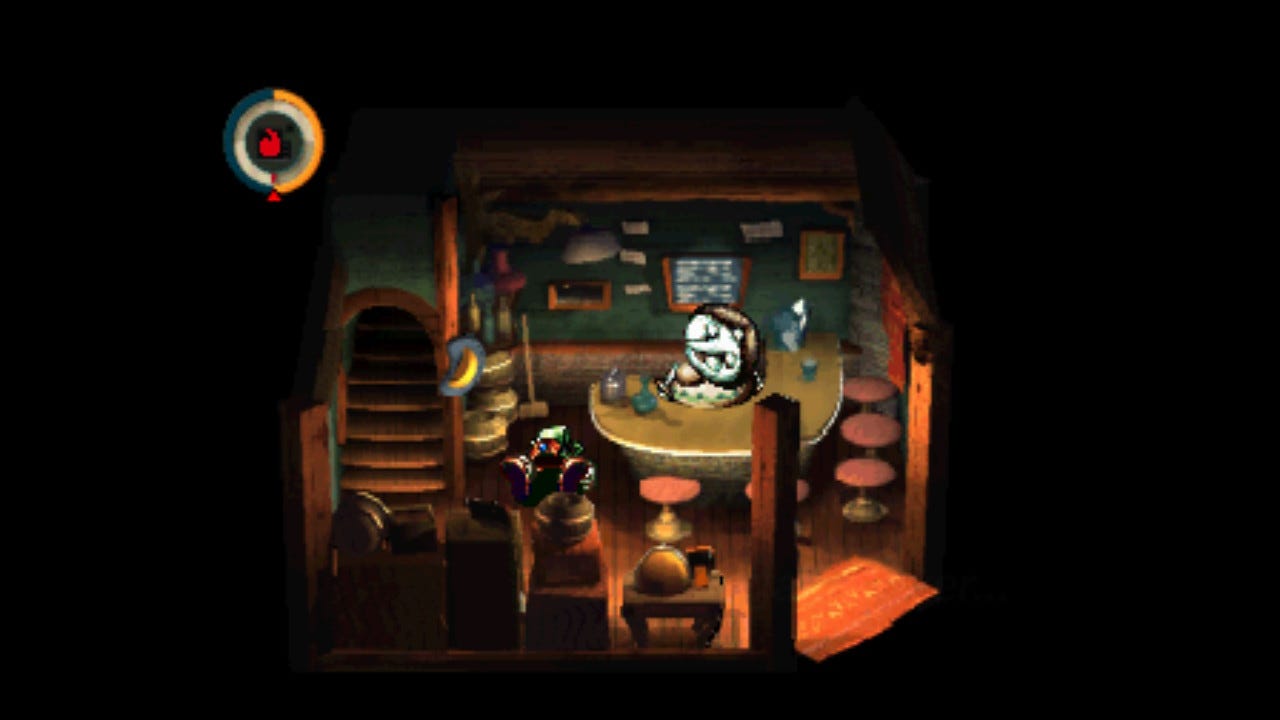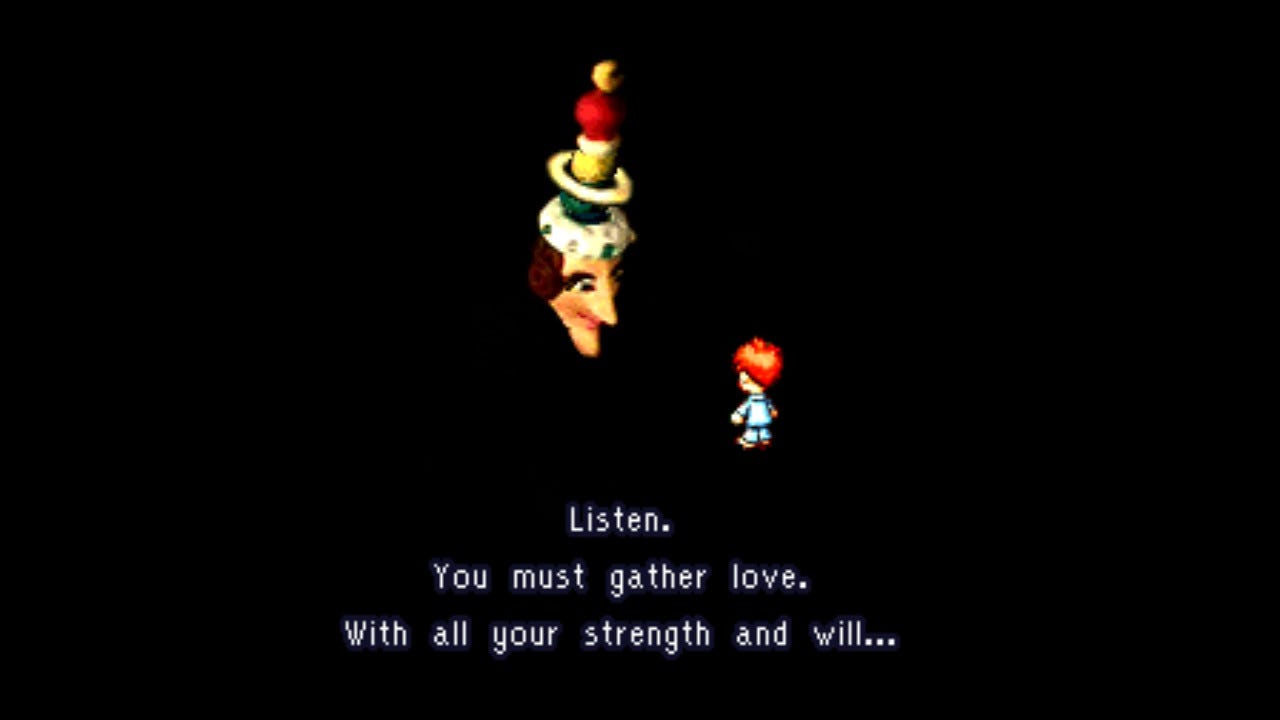Astrolabe 6: Building a remixed world on the moon

Finally, that post about world building
Since I was a kid, my hobbies have been equally divided between reading and gaming. I discovered fantasy fiction around the same time I discovered Japanese RPGs like Final Fantasy VI and Chrono Trigger. And so, over the years, they’ve both become immensely influential on my work. The Thousand Shattered Gods, my WIP epic fantasy, is directly inspired by Japanese RPGs, and pulls a lot of cues from my favourites.
A month ago, my awesome agent Eric was reading a draft of my other book, The Rose and Honey Soul, and he hopped on Twitter to make a comparison that knocked my socks off. Eric and I initially connected over our love of video games, so it shouldn’t come as a surprise that he’d compare my book to two of the best modern games, but it’s a lot more common to see books compared to other books. You know, “It’s like A Game of Thrones meets The Hunger Games.” That pretty much sums up all my work (for any editors looking for an easy sell through marketing. Though that might be underselling sales and merchandising potential.)
I'm reading @adribbleofink's novel, and it feels like Horizon: Zero Dawn smashed with The Last Of Us, and it is DELICIOUS.
— Eric Smith (@ericsmithrocks) 6:08 PM ∙ Sep 2, 2020
Honestly how dare you, Aidan.
See, the thing is—and this is why Eric is SO GOOD—The Rose and Honey Soul was directly inspired by video games. But, Eric didn’t know this when he read it. He’s a sharp cookie. The Rose and Honey Soul came together when I wondered what Dark Souls would be like if it was set in a post-apocalyptic version of the Pacific Northwest. And every step of the way, I turned to my love for gaming, and exploring virtual worlds, while writing about The Rose and Honey Soul’s party of heavily equipped knights, rangers, and rogues, and for inspiration as I built the world and created its characters.
One of my absolute favourite world building tricks from games, especially open world games like Breath of the Wild or Horizon: Zero Dawn, is how they guide the player’s attention to certain aspects of the landscape, hinting at what’s to come, and where the they’ll end up later in the game. Sometimes five minutes later, sometimes five hours. But they’ll get there eventually.
There’s something special about walking out of Link’s cryovac chamber and seeing Hyrule Castle hunkered off in the distance, Ganon’s dark energy swirling maliciously, and knowing that it will be many, many hours until you’re strong enough to get there. But you also know you WILL get there. Breath of the Wild is so brilliant at signposting its critical path—highlighting the way forward with subtle visual cues that also serve as payoff for observant players.
After you tear your gaze away from the corruption surrounding Hyrule Castle, you might notice smoke and flame signalling a nearby camp fire, or the crumbling remains of the Temple of Time in the distance. Breath of the Wild features a huge open world full of promise, but these signposts catch the player’s attention, and they become part of a pre-planned narrative path that eventually leads to Hyrule Castle and a confrontation with Ganon.
Open world games are FULL of this kind of thing. As you reach new areas, you see, far off in the distance, something interesting, a landmark or signs of a fellow traveller. You might not get there right away, but eventually you will, and there’s a rush of excitement when you realize you finally reached that shrine you spotted five hours earlier.
So how do pull this sort of carrot-on-a-stick worldbuilding into novel writing? As a writer, you have omniscient knowledge of the world, and also a captive audience who can only see what you choose to show them, which differs vastly from games, where you have to use visual cues to pull the player in the right direction. With a book, they just turn a page to stay on the critical path. So you have to be careful not to be too obvious and overt about your worldbuilding—you don’t want the reader feeling like they’re being jerked around. I’ve found it’s the little things that matter most.
A tip I picked up from, I think, Patrick Rothfuss, is that you can seed future worldbuilding early in your novel by having the protagonist brush briefly against something that won’t matter until many chapters (or even books) later. Maybe they’re sorting through their purse and they have to sift around the Hikkenian coins they can’t spend in their home country; perhaps they see a performing troupe whose lead Druid performs a transformation spell at the end of their act; they hear laughable rumours about a dragon in Bergonia; or bump into an envoy leaving Bracken Castle hiding their livery and drawing a conspicuous hay wagon behind them.
Like the Temple of Time far off in the distance, or the traveller from Kakariko village Link meets on the road, they tell the reader, “I might not matter yet, but I will.” And nothing makes a reader feel better than when that light bulb goes off above their heads many chapters later when they remember that transforming druid, or know exactly how Bump Windowlock the kitchen scullion is going to pay the conniving trader from Hikken.
It’s not that gaming is the only medium to use this visual style for setting up later narratives, or seeding worldbuilding, but it’s my favourite example because of the way it helps the player feel like an active participant in the story. One writer who I think does this really well is Brandon Sanderson. He builds these huge, expansive worlds, and he’s constantly inserting things into his stories that don’t pay off for volumes, but reward close reads and dedication when they finally reveal their purpose in the narrative.
The Thousand Shattered Gods and The Rose and Honey Soul are both set in a relatively small geographical location compared to the overall worlds I’ve created, and so I drop a lot of hints in both of them that give glimpses at their broader worlds and future storylines. Smoke trailing in the sky. A suspicious hay wagon. A brown bear wearing a druid’s cloak. One of The Thousand Shattered Gods’s major themes is the naivety that comes with golden chains and a privileged lifestyle, and how much we don’t know about the world we haven’t experienced first hand. I hope y’all will have just as much fun discovering the world as protagonist Jane Aldebourne. She’s got a hell of a journey ahead of her, and, if you keep your eyes open, you just might catch a few hints of what’s to come.
Out & About
(Out & About is where I highlight my work around the web—some recent and some old favourites.)

I’m not the only writer heavily influenced by gaming. In 2019, I spoke with a bunch of great people, including Tamsyn Muir, Scott Lynch, and Troy L. Wiggins, about the golden age of Japanese RPGs, and how their work has been influenced as much by Hironobu Sakaguchi as by J.R.R. Tolkien.
When I think back to my childhood and teenage years, when my literary tastes were being forged in the crucible of youthful emotion and impressionism, particular scenes come to life: Sam carrying Frodo up Mt. Doom. The Reaper chasing Wil Ohmsford through the Westland. Marle hugging Crono on top of Death Peak.
Most fantasy readers won’t need a reminder of what books the first two scenes come from (Lord of the Rings by J.R.R. Tolkien and The Elfstones of Shannara by Terry Brooks), and most Kotaku readers won’t miss the reference to the classic Japanese role-playing game Chrono Trigger. And for some, all three of those works are of equal importance. Today’s fantasy novelists are just as likely to have been inspired by JRPGs as they are J.R.R. Tolkien. For some authors, Celes’ performance at the Opera House is just as much of a storytelling touchstone as young Simon fleeing Pryrates beneath the Hayholt.
Read “How Japanese RPGs Inspired A New Generation Of Fantasy Authors” on Kotaku
Some more:
- Please, Judge This Book By Its Cover (Uncanny Magazine)
- Becoming Gandalf (Medium)
- A Newbie’s Guide to Brandon Sanderson, the Cosmere, and the Stormlight Archive (Barnes & Noble SFF Blog)
LTTP—Moon: Remix RPG Adventure (PlayStation, 1997)
( LTTP stands for “Late to the Party” and is a regular column where I let Twitter decide which retro game I’ll play for an hour. Do your worst, Twitter!)

Somewhat coincidentally—but more likely the result of a subconscious push toward more relaxing experiences, to counterbalance the existential dread that is 2020—I’ve been playing a lot of games lately that focus on narrative and creative problem solving, and feature little-to-no violence. I’ve been wanting to talk about this, so instead of polling Twitter for this edition of LTTP, I’m using this space to write about one of the most striking examples: Moon: Remix RPG Adventure.
(I’ll get back to the poll for Astrolabe #7. Promise.)
Moon: Remix RPG Adventure is a combatless deconstruction of Japanese RPGs released for the PlayStation in 1997. Its original release never left Japan, but it still managed to build a cult following for its clever and heartfelt approach to the genre. A long-in-the-works fan translation was under way, but progress was slow, before, out of the blue, Onion Games announced they were releasing a port of the game on the Nintendo Switch, and a localized version would release worldwide in 2020.

From the moment the curtain rises, Moon is different. You start off in control of a knight in a fantasy world, but you’re in fact playing as a kid who’s playing his favourite fantasy roleplaying game. You cut through various scenes in the fake game, as the kid makes progresses, and we see the knight do valiant, knightly things—but the kid stops playing before he can defeat the game’s final boss. That night, as he sleeps in bed, the kid is swept into the very game world he obsessively explored through his TV screen.
Unlike the knight, the kid has no sword, and no way (or will) to fight monsters, or, well… anyone. Instead, Moon is a game about gathering love, nurturing others, and spreading joy. The boy travels the world at a snail’s pace, running into all sorts of odd characters, all of whom have routines they follow while the game goes through its day/night, seven day a week schedule. Like Majora’s Mask, the player has to work within a time limit as they explore, meet new characters, gather items, and make progress. Unlike Majora’s Mask, as long as you make it back to your bed before your character runs out of energy, you keep your progress. The more love you gather, the more energy you get, expanding your range and options.
Almost immediately, you learn that the knight you play as in the game is far from a hero, and that the actions you were taking while playing as him in the fake video game were often selfish and always heinous when viewed through the perspective of the people and monsters that actually inhabit the world. The player spends a large majority of the game writing the wrongs committed in the name of valour and tropes.

I wasn’t sure what to expect when I went into Moon. I knew of its cult status, and am constantly desperate for cozy, kind-hearted games, and it delivers on all fronts. The writing—localized by the brilliant Tim Rogers of Action Button—is smart and funny, touching, and effecting. The world is ugly, doubly so when blown up on an HD screen, but it’s full of genuinely unique characters, and locations that at once pay tribute to and deconstruct JRPG tropes.
I’ve put about five hours into Moon: Remix RPG Adventure, and it’s living up to its reputation as a subversive, smart, and warm adventure game that cleverly deconstructs my favourite genre. It’s far from a technical masterpiece, and the experience could be improved immensely if the protagonist’s walking speed was doubled, but it feels so good to spend time in the world, helping people with their problems, that, just like Animal Crossing: New Horizons, it’s the perfect antidote for 2020.
Moon: Remix RPG Adventure was created by Love-de-Lic and co-directed by Yoshiro Kimura, Taro Kudo, and Kenichi Nishi. It was originally released in Japan by ASCII Entertainment in October, 1997 for the Sony PlayStation, and later ported to the Nintendo Switch by Onion Games and released in Japan in 2019, and worldwide in 2020. It’s available now on the Nintendo eShop.
Recommended Reads
Geek Feminist Revolution by Kameron Hurley
I’m a huge fan of Hurley’s whole body of work, but it’s her non-fiction, which explores geekdom, SFF, writing, feminism, and so much more, that really hits me hardest. Geek Feminist Revolution is her collection of essays, many unique to the book, and is absolutely essential for anyone who wants to better understand the complexities of geekdom, SFF, and modern culture at large.
Hurley is a hugely prolific essayist, and often does wide-ranging blog tours leading up to the release of her new novels. The Geek Feminist Revolution gathers them from her blog and around the web, and adds several new pieces. In a sense, they are considerations of geekdom and SFF, but they’re more than that: they’re cunningly crafted narratives examining issues of sexism, racism, and dismissiveness plaguing modern society.
You can read my review of Geek Feminist Revolution at the Barnes & Noble SFF Blog (RIP). It’s brilliant.
Quest Markers
(Quest Markers is a collection of the coolest stuff I’ve read around the web lately.)
- N. K. Jemisin Has Been Named a MacArthur Fellow (Tor.com)
- 'This is my passion,' says man who's been running Dungeons & Dragons campaign for over 38 years (CBC)
- 8 SFF Books That Center Mental Health (Tor.com)
- Why So Many Readers Are Turning to Octavia Butler’s Apocalypse Fiction Right Now (Slate)
- How The Pandemic Has Exacerbated The Gender Divide In Household Labor (Buzzfeed)
- 60 works of Canadian fiction coming out in fall 2020 (CBC)
- A Magical Deal Goes Sideways in This Excerpt From Cairo-Set Fantasy A Master of Djinn (io9)
- Writing Women Characters Into Epic Fantasy Without Quotas (Tor.com)
- How To Do An Essay Collection (Agents and Books)
- Skyhorse Publishing’s House of Horrors (Vanity Fair)
- Longtime Blizzard CEO Mike Morhaime starting new game studios and publishing company (Washington Post)
- Why J.R.R. Tolkien Never Won a Hugo Award (The Wertzone)
End Step
This was a fun one! I really like being able to tie together my two favourite hobbies, and articulate how they both feed one another and inspire me. I’ve got a few irons in the fire in the form of non-fic pitches, but right now my focus is on really nailing down the pitch and sample for Fight, Magic, Items. So, if you’ve got any spare XP, mind slinging it my way? I could use a level up.
Let me know what you’d like me to cover in Astrolabe #7 by getting in touch! Thanks for reading!
Support
There are lots of ways to support Astrolabe and my other work. Check ‘em out!
- Patreon: http://patreon.com/adribbleofink
- Ko-fi: http://ko-fi.com/aidanmoher
- Paypal: http://paypal.me/AidanMoher
Keep In Touch
Enjoy Astrolabe? Want more SFF and retro gaming goodies? You can find me on Twitter and my website.
Credits
Astrolabe banner photo by Shot by Cerqueira on Unsplash

